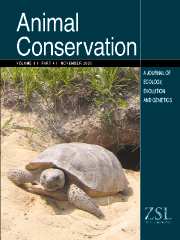Crossref Citations
This article has been cited by the following publications. This list is generated based on data provided by
Crossref.
Fecske, Dorothy M.
Barry, Ronald E.
Precht, Francis L.
Quigley, Howard B.
Bittner, Steven L.
and
Webster, Tracy
2002.
HABITAT USE BY FEMALE BLACK BEARS IN WESTERN MARYLAND.
Southeastern Naturalist,
Vol. 1,
Issue. 1,
p.
77.
Cegelski, C. C.
Waits, L. P.
and
Anderson, N. J.
2003.
Assessing population structure and gene flow in Montana wolverines (Gulo gulo) using assignment‐based approaches.
Molecular Ecology,
Vol. 12,
Issue. 11,
p.
2907.
Laundré, John
and
Clark, Tim W.
2003.
Managing puma hunting in the western United States: through a metapopulation approach.
Animal Conservation,
Vol. 6,
Issue. 2,
p.
159.
Anderson, Charles R.
Lindzey, Federick G.
and
McDonald, David B.
2004.
GENETIC STRUCTURE OF COUGAR POPULATIONS ACROSS THE WYOMING BASIN: METAPOPULATION OR MEGAPOPULATION.
Journal of Mammalogy,
Vol. 85,
Issue. 6,
p.
1207.
JONES, MENNA E.
PAETKAU, DAVID
GEFFEN, ELI
and
MORITZ, CRAIG
2004.
Genetic diversity and population structure of Tasmanian devils, the largest marsupial carnivore.
Molecular Ecology,
Vol. 13,
Issue. 8,
p.
2197.
Norton, James E.
and
Ashley, Mary V.
2004.
Genetic variability and population structure among wild Baird's tapirs.
Animal Conservation,
Vol. 7,
Issue. 2,
p.
211.
MCRAE, B. H.
BEIER, P.
DEWALD, L. E.
HUYNH, L. Y.
and
KEIM, P.
2005.
Habitat barriers limit gene flow and illuminate historical events in a wide‐ranging carnivore, the American puma.
Molecular Ecology,
Vol. 14,
Issue. 7,
p.
1965.
Biek, Roman
Drummond, Alexei J.
and
Poss, Mary
2006.
A Virus Reveals Population Structure and Recent Demographic History of Its Carnivore Host.
Science,
Vol. 311,
Issue. 5760,
p.
538.
STONER, DAVID C.
RIETH, WENDY R.
WOLFE, MICHAEL L.
MECHAM, MCLAIN B.
and
NEVILLE, ANN
2008.
Long‐Distance Dispersal of a Female Cougar in a Basin and Range Landscape.
The Journal of Wildlife Management,
Vol. 72,
Issue. 4,
p.
933.
Holderegger, Rolf
and
Di Giulio, Manuela
2010.
The genetic effects of roads: A review of empirical evidence.
Basic and Applied Ecology,
Vol. 11,
Issue. 6,
p.
522.
Thompson, D. J.
and
Jenks, J. A.
2010.
Dispersal movements of subadult cougars from the Black Hills: the notions of range expansion and recolonization.
Ecosphere,
Vol. 1,
Issue. 4,
p.
1.
Loxterman, Janet L.
2011.
Fine scale population genetic structure of pumas in the Intermountain West.
Conservation Genetics,
Vol. 12,
Issue. 4,
p.
1049.
Castilho, Camila S.
Marins-Sá, Luiz G.
Benedet, Rodrigo C.
and
Freitas, Thales R.O.
2011.
Genetic structure and conservation of Mountain Lions in the South-Brazilian Atlantic Rain Forest.
Genetics and Molecular Biology,
Vol. 35,
Issue. 1,
p.
65.
Miotto, R. A.
Cervini, M.
Figueiredo, M. G.
Begotti, R. A.
and
Galetti, P. M.
2011.
Genetic diversity and population structure of pumas (Puma concolor) in southeastern Brazil: implications for conservation in a human-dominated landscape.
Conservation Genetics,
Vol. 12,
Issue. 6,
p.
1447.
Naidu, Ashwin
Smythe, Lindsay A.
Thompson, Ron W.
and
Culver, Melanie
2011.
Genetic Analysis of Scats Reveals Minimum Number and Sex of Recently Documented Mountain Lions.
Journal of Fish and Wildlife Management,
Vol. 2,
Issue. 1,
p.
106.
Onorato, Dave
Desimone, Rich
White, Craig
and
Waits, Lisette P.
2011.
Genetic assessment of paternity and relatedness in a managed population of cougars.
The Journal of Wildlife Management,
Vol. 75,
Issue. 2,
p.
378.
Sawaya, Michael A.
Ruth, Toni K.
Creel, Scott
Rotella, Jay J.
Stetz, Jeffrey. B.
Quigley, Howard B.
and
Kalinowski, Steven T.
2011.
Evaluation of noninvasive genetic sampling methods for cougars in Yellowstone National Park.
The Journal of Wildlife Management,
Vol. 75,
Issue. 3,
p.
612.
Andreasen, Alyson M.
Stewart, Kelley M.
Longland, William S.
Beckmann, Jon P.
and
Forister, Matthew L.
2012.
Identification of source‐sink dynamics in mountain lions of the Great Basin.
Molecular Ecology,
Vol. 21,
Issue. 23,
p.
5689.
Holbrook, Joseph D.
DeYoung, Randy W.
Tewes, Michael E.
and
Young, John H.
2012.
Demographic history of an elusive carnivore: using museums to inform management.
Evolutionary Applications,
Vol. 5,
Issue. 6,
p.
619.
LaRue, Michelle A.
Nielsen, Clayton K.
Dowling, Mark
Miller, Ken
Wilson, Bob
Shaw, Harley
and
Anderson, Charles R.
2012.
Cougars are recolonizing the midwest: Analysis of cougar confirmations during 1990–2008.
The Journal of Wildlife Management,
Vol. 76,
Issue. 7,
p.
1364.


